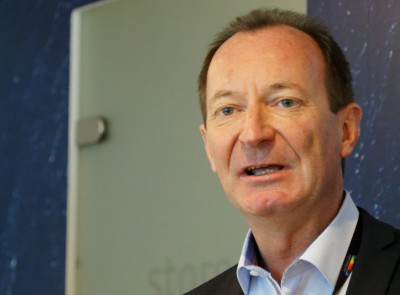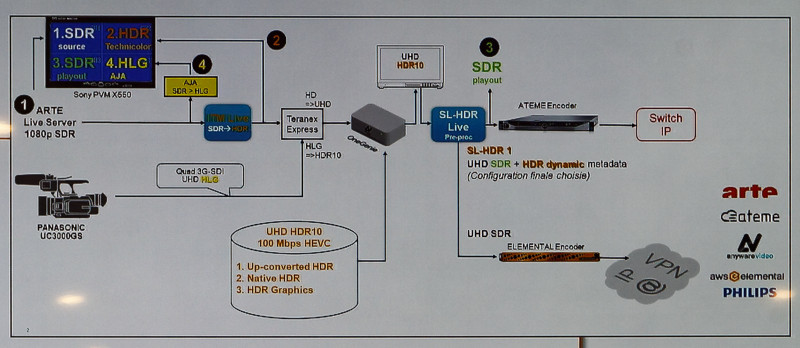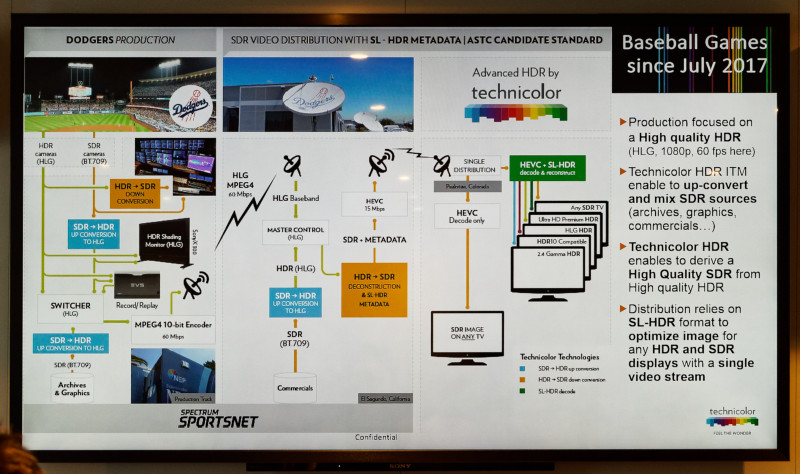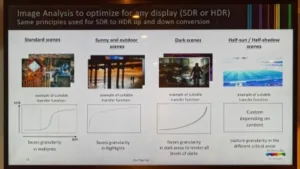SES held a series of Tech Talks in its meeting room suite up in the balcony of Hall 1. These are usually interesting and the one we went to was no exception. The topic was the lessons learned in trying some HDR productions and transmissions by Arte, the Franco/German public service broadcaster. The main speaker was Lothaire Burg of Arte France and he was supported by Guy Ducos of Philips, as the Philips/Technicolor HDR technology was being used for transmissions. The companies have been working together on new video since January 2016 when Arte wanted to develop 360 deg video.
 Lothaire Burg of Arte gave the talk. Image:Meko
Lothaire Burg of Arte gave the talk. Image:Meko
Arte likes to be an early adopter of technology and was one of the first with HD and so sees the process of looking at HDR as part of this. As well as looking at video, the company is developing its audio processes to support next generation object-based audio and often has six channels of audio to support multiple languages and versions. In addition to these changes, the company is trying to ensure more convergence between its linear and non-linear offerings.
Content has to be created very quickly and you need fast processes, Burg said, and that means you need to work closely with content producers. The company is trying to develop a full UHD production chain. There is a ‘realistic timetable’ and the aim is to get all of this technology rolled out in around three years.
 Guy Ducos of Philips helped the talk along. Image:Meko
Guy Ducos of Philips helped the talk along. Image:Meko
There is a question of ‘what is HDR’, but Arte is relying on ITU R-BT2100 and that means the use of the PQ curve or HLG. There need to be interfaces for VOD, OTT, Video over IP, for HbbTV and for streaming. The experimental work with Technicolor is intended to support 50P as Arte likes 50P at FullHD and UltraHD. In fact, as discussed later, there has been some work done to decide whether, if you have a limited bit rate available, it’s better to supply less compressed FullHD or more compressed UltraHD. To make it all work well, you have to be able to deal with all your assets and also have to be able to handle topics such as archiving.
Arte is trying to ensure that production can be done using an IP-based architecture, based on standards, and the plan is to use that platform by 2022. In audio, the company is working on service-based audio (such as language etc) and also wants to add object-based audio that is accessible to the user to control (e.g. commentaries). One reason for the work being done is that, as a public service broadcaster, Arte wants to be in a good position to support the Olympics, which will be in Paris in 2024. By then, any new technologies should be well developed and reliable.
In between now and then, Arte expects to see a significant renewal in TVs in France around 2022 because around that time, a lot of sets will be replaced because they were bought in a wave around the time of the analogue switch off (ASO). (Actually, ASO was completed in France in April 2012, so rather than a big peak in 2022, we would expect a boost from next year through to 2022).
One of the limiting factors on what Arte is doing is that there is a view that technologies must be available via DTT, which remains important in France.
 Arte was conducting tests during IBC. Image:Meko
Arte was conducting tests during IBC. Image:Meko
Arte has been running a test transmission of HDR from the 12th to the 22nd September (Arte to Conduct Ultra HD and HDR Trial Next Month). During that time, different technologies and quality levels are being tried to see what the result is. There was a variety of content being transmitted in 1080i and 1080P in UltraHD and FullHD with SDR or HLG-based HDR. Burg said that the monitors that it had found to use in checking content were basically good, but there are many settings and that means that there is scope for errors. Both up and down conversion is needed to ensure that content can be used in every way that the firm needs. A 3D LUT can be used to help with this and that is fairly simple, but if you change camera, the LUT may need to be changed.
As well as HDR, Arte tried doing some work with UltraHD with 50P and SDR. ‘Le Corsaire’ was recorded in UltraHD SDR in April 2016 and was broadcast on Astra and Fransat HbbTV. One issue is that if broadcasting the kind of theatrical and operatic productions that it specialises in may need careful lighting and it is important that the director of photography and stage & lighting managers work together.
In July 2017, Carmen was captured in UltraHD with HDR using the HLG EOTF transmitted using Technicolor technology to scale up those parts of the content that were in SDR. Content was streamed in SDR, HDR10 and SL-HDR as well as HLG and there was no problem to create the different streams from UltraHD HDR masters.
Again, Astra and Fransat were used, with HbbTV by AWS. Burg said that the OB van arrived in the morning, with the performance the same evening (although there was a lot of planning in advance). All the capture equipment was from Sony and encoding was done with an Ateme Titan Live encoder, which was able to handle all the formats. Cobalt boxes were used to support the Technicolor technology.
The company found that the HD and SD content created from the UltraHD capture were of good quality but needed careful coordination and new operational workflows are needed. There were some problems with TV sets receiving the broadcast that did not correctly identify HLG signals and didn’t look good. One of the things learned was that more light was needed on the stage, but the result was a good and dynamic picture with a clear appreciation of the depth of the stage in medium and long shots. SDR content (such as subtitles and logos) needed some thought – “You have to know what you want before you start”, Burg said. He also said that good SDR can be made into good HDR. Old movies and black and white content can be challenging and need a lot of care.
SDR & HDR can happily be transmitted in parallel. In terms of bit rates, Arte found that at 15 Mbps (in HEVC), visible artefacts started to appear. Content conversion between SDR and HDR needs care to pick the peaks and AI can be helpful in doing it well although you need to keep a close eye on black levels to keep them down. There was just a two frame delay in the processing. However, simply relying on the HLG curve in the conversion is not good enough for everything. Down conversion really needs to be done on a frame by frame basis to bring down the peak brightness from 1,000 cd/m² to 100.
 Different transfer curves need to be used for different content being converted from SDR to HDR. Image:Meko
Different transfer curves need to be used for different content being converted from SDR to HDR. Image:Meko
As Technicolor had highlighted when we talked to them at the event, the Technicolor technology has been used in live broadcasting of baseball in the US since July 2017.
 Technicolor technology has been used in the US for over a year. Image:MekoArte is a public service broadcaster and in France is regulated by the CSA which has mandated that all UltraHD content broadcast by Arte must also be available in HD. Thought needs to be given to workflows to minimise the number of up and down conversions.
Technicolor technology has been used in the US for over a year. Image:MekoArte is a public service broadcaster and in France is regulated by the CSA which has mandated that all UltraHD content broadcast by Arte must also be available in HD. Thought needs to be given to workflows to minimise the number of up and down conversions.
The current experimental broadcast has been done on two channels with one carrying a ‘reference’ channel, and with the second used for a range of different experiments in technology and format.
Highlights
Burg said that there was good news in that it was relatively easy to put an UltraHD HDR production into place with a couple of days of set up and the technology is stable and mature enough to allow 24/7 operation. Good SDR can look very good in HDR. Dynamic metadata makes a real difference in conversion of different sources. The Technicolor technology works to allow different and multiple streams starting from a single UltraHD SDR production.
However, not everything was positive, there were some negative lessons learned. For example, artefacts in source content can become more visible after up-conversion and so optimisation before the process is important. If you limit the ‘aggressiveness’ of the HDR, you can minimise the problems, but viewers can feel a bit ‘underwhelmed’ with no ‘Wow’ effect. In the US, the HDR tends to be more aggressive while in Europe it is more conservative. Arte plans to do more work to minimise noise to allow more aggressive HDR.
Another point learned is that content mastered on an LCD at 1000 cd/m² can look not so good when viewed on an OLED TV with just 300 cd/m² of peak brightness. It also became clear that UltraHD displays definitely look better when driven by UltraHD content. Judder can be a problem at 25P in TV sizes of 55″ and above.
In the sets, the experiment has shown that DR10 is better implemented in TV sets and some sets do not handle HLG properly with static metadata not being handled correctly.
Discussions on bitrates
There were questions at the end, especially about bit rates with a number of questioners wondering about the comment that 15 Mbps was OK for UltraHD with HDR. In discussion, it became apparent that part of the reason for the relatively low bit rate requirement was that Arte’s content is not like, for example, sport content with a lot of motion and details such as crowds. One of the questions that Arte was trying to decide was whether a budget of 15Mbps looks better in UltraHD with HDR or in 1080P50 with HDR. It is also comparing 20 Mbps UltraHD with 15 Mbps HD. Arte also said that the capacity of a single satellite Mux is 37 Mbps, which could be split between a 20 Mbps UltraHD channel and a 17 Mbps HD channel.
In the longer term, Arte expects bandwidth allocation to be decided according to the genre of content being displayed.

